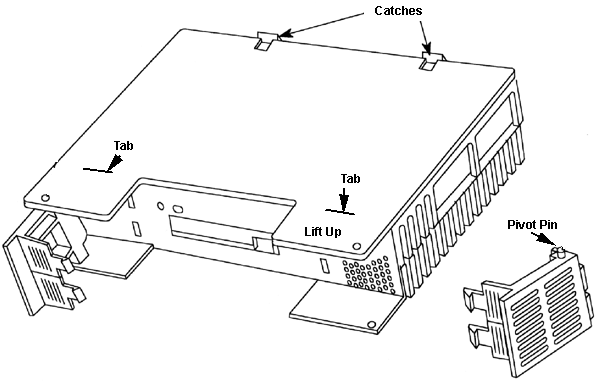|
@8EFD.ADF SCSI Cached Disk/Diskette Controller
DASD Module
Open DASD Module
Opened DASD Layout
HD Rails
HD Drive Shapes Supported
Floppy Drive Stuff
Drive Spacer
ADF Section
DASD Module (#6222)

CR1 Run/Check LED
CR2 Drive in Use LED
F1 125 V / 1.5 A Littelfuse
F2,3 125 V / 2 A Littelfuse
J1 DB26 port for Setup Aid
J2 C60 port for SCSI
P1,2 Backplane connectors
P3,4,6 Drive power connections
P5 40-pin FD header (8570 style)
P7 Unknown 4-pin header
P8 SCSI connector
RP1 Termpack
U10 80C188
|
U17,21 30-pin SIMM socket
U22 SCSI BIOS Even
U29 Hitachi HM62256LFP-12T
U31 20.0 MHz osc
U33 SCSI BIOS Odd
U37 15F7917
U43 SCSI µcode ROM
U52 15F6903 SCSI Cache/data flow controller
U53 33F6715 SCSI MCA iface/BM DMA controller
U57 24.0 MHz osc
U62 82077-1 Floppy controller
U63 Adaptec AIC-6250EL
|
U43 SCSI µcode ROM - D27512-200;
sticker 57F2716, internally 57F2717
The Disk Module consists of a double-wide shroud and a Disk/Diskette Adapter
Card. The Disk/Diskette Adapter Card contains 0.5MB of DASD Cache Memory
(should take two 1MB Spock compatible 30 pin SIMMs), and supports up to two
1.6" high 3.5" drives and a 1.44MB Diskette Drive installed inside the shroud.
The DASD Module has a C60 SCSI port on the bottom and a triple-row DB26 (floppy
port for setup aid?).
SCSI BIOS Upgrade Ready
The upgrade SCSI BIOS chips for the SCSI and SCSI w/cache (92F2244/92F2245)
work in this board, and probably all others. If you look at the SCSI w/cache,
single oscillator, the parts are the same.
Note: PS/2 adapters should not be installed in the
slot #9 position. This is due to limitations with setup and diagnostic code
recognizing such adapters in that position.
2.88MB Support
The D40 (possibly C40 as well) support the 2.88MB floppy. It's in the setup
options...
Set ID
Your C: MUST be set to ID6, a second HD MUST be set to ID5, as the setup
lacks selectable start sequence. The SCSI adapter itself is ID7.
Something I haven't seen- if you add an auxiliary DASD module to slots 1 and
2, the drives must use ID0 to ID4. The drives within the Auxiliary DASD module
are considered as external SCSI devices.
Open the DASD Module

Pull up on one of the ears and twist the latches out. (Important to remove
them!). Now go to the back of the module and undo the two catches. Can't miss
them. The DASD module is the only one to have them. Pull the cover out. It will
pivot on the two tabs at the front edge.
Note: If you left the latches on, this will NOT work.
DASD Layout

Once you open the DASD up, the top swings back, held at the bottom by the
data and power cables.
HD Rails

Hard Drive Shapes Supported
The 7568 requires the squarish 0661/0662/0663 drives to fit the 7568
specific drive rails. The mounting holes on the 1" high 0662 do NOT match. You
can drill a new pair of screw holes in the rails, but keep this in mind- the
on-board SCSI is 50 pin, so why not keep with the 0661/3 1GB-2GB range?
Floppy Drive

The drive in the 7568 is used in the Model 70, PN 15F7503. It is a modified
ALPS DFP723D12F with a PCB screwed in place on the top. The drive that came
with an 8570 has a clear plastic sled screwed on, but the same PN 15F7503.
Another 8570 drive is a Mitsubishi MF355C-599MB.
Some pictures stolen from Alfred Arnold's page:


Remove the Floppy Drive
Remove the clear plastic spacers between the drive latches. Unscrew the two
screws on the outside of the shroud (they screw into the FD's bottom!). Spread
the two sets of latches one side at a time, pulling up on the FD. Once the FD
rails are past the latch, pull it back and up.
The floppy rails are held on with two screws per side. The funky thick black
bezel will come off quite easily AFTER you unscrew the front rail screw. Trust
me. Do NOT try to pry the thick bezel off, it is rather ready to fall off once
the front screws are half way out.
Drive Spacer

The important dimension is along the top. Take all your measurements from
that edge. The spacer is pictured upside-down to emphasis the critical
edge.
The 5 mm slot can be a bit wider, the 12 mm slot depth may be deeper. Round
off all sharp corners.
AdapterID 8EFD SCSI Cached Disk/Diskette Controller
SCSI Adapter Memory Location
Selects 32kb memory block used for it's BIOS ROM. There are five
memory ranges.
<"Segment C000"
(mem c0000-c7fff)>, C400 (c4000-cbfff), C800 (c8000-cffff),
Segment CC00 (cc000-d3fff), D000 (d0000-d7fff), D400 (d4000-dbfff),
D800 (d8000-dffff), "ROM Disabled"
SCSI I/O Address
Choose the I/O address for each adapter
<"3540-3547"
(io 3540h-3547)>, 3548-354F, 3550-3557, 3558-355F, 3560-3567,
3568-356F, 3570-3577, 3578-357F
SCSI Arbitration Level
Select the arbitration level that SCSI will use to transfer
data.
<"Level C" (arb 12)>,
D, E, 1, 3, 5, 6, 8, 9, A, B
SCSI Adapter Fairness On/Off
Whether the adapter releases control of the bus when it has been
using it exclusively.
<"On" >, "Off"
ROM Wait State Disable
Enable/Disable ROM Wait State
<"Enable Wait State">,
"No Wait State"
SCSI Adapter Address (ID)
Change the SCSI ID of the adapter.
<"7">, "6", "5",
"4", "3", "2", "1", "0"
Address Burst Boundary
Determines the maximum number of bytes per burst
< "No Boundary">,
"32-Byte Boundary", "64-Byte Boundary", "128-Byte Boundary"
Diskette DMA Arbitration Level
DMA channel diskette adapter will use to transfer data.
<"Shared level 2 only"
(ARB SharedArb 2)>
Diskette Adapter Fairness On/Off
Whether diskette adapter releases control of the bus when it has
been using it exclusively.
<"Off">, "On"
Diskette Primary/Alternate Addresses
Primary or secondary address range of the diskette portion.
<"Primary 03F0-03F7"
(io 3F0-3f7 int 6)>, "Alternate 0370-0377" (io 370-377 int 6)
|